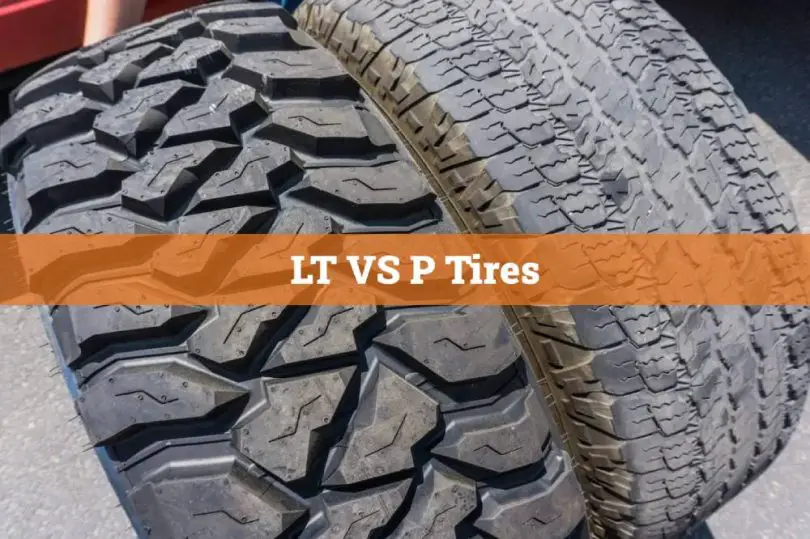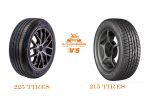If a tire has the letters LT in front of the numbers, it’s for heavy-duty and light-duty pick-up trucks, vans, and SUVs.
In front of tire numbers, the letter P stands for p-metric or passenger vehicle. These tires are good for cars and trucks that do not carry heavy loads or drive on gravel roads.
Let’s see how they compare in detail!
LT vs P Tires: How Do They Differ?
1. Where to use it?
LT tires
These tires are heftier and can handle more weight than the P tires. LT tires are built for carrying cargo, not passengers. They do well in difficult driving conditions and have excellent off-roading capabilities.
P tires
These tires were manufactured for crossovers, sedans, coupes, or lighter considered vehicles. They perform excellently under dry or wet weather conditions. You can also use them on trucks if you are not going to drive on rough ground.
Winner
If we look at the strongest tire, then the LT tire takes the win. They have broader, reinforced sidewalls. But, it depends on if you want solid tires for a passenger vehicle or something that can handle heavy loads and rugged terrain.
2. Mileage
LT tires
The weight and the size of the tire are why you can lose MPG. The LT tires are thicker for heavy-duty use, although you can obtain some lesser-weight LTs. As for replacing your tires should happen no matter what at 10 years. You should inspect your tires and replace them at the 6-year mark.
P tires
These P-Metric tires are smaller and lighter in weight than the LTs; however, the same guidelines apply when inspecting or replacing your tires. Replace them after 10 years regardless of how the tread looks, and at least get them checked at 6 years to be safe.
Winner
The P-Tires take the win for better mileage overall. When you are looking at when to replace your tires, the same rules apply for both LT and P tires.
3. Flexibility
LT tires
Due to the added air pressure, LT tires are not flexible.
P tires
Since they are lighter and smaller in size, they are more flexible.
Winner
The P-Tires win for flexibility.
4. Comfortable ride
LT tires
When it comes to driving smoothness, LT tires drive rough.
P tires
These tires drive more smoothly than the LT tires. They carry passengers and no cargo, so they are made for riding more pleasantly.
Winner
The P-Tires take this one as it is a more comfortable ride.
5. Air pressure and tire load rating
LT tires
These durable tires are inflated to their topmost potential. The tires need higher air pressure to lug the equivalent cargo. They have a load range of 10 plies.
P tires
For P-Metric, you can get a tire load-carrying capacity in Standard or Extra Load. The standard version has a maximum inflation pressure of 35 psi. The extra load variety has a maximum inflation pressure of 41 psi. The load range for the passenger tires is 4 ply.
Winner
P-Tires are less inflated than LT Tires, whereas the LTs are inflated to the top of their potential. They also have a higher load rating. LT tires win this battle.
6. Sidewall protection
LT tires
These tires have reinforced and thicker sidewalls to handle rough terrain and carry heavy cargo.
P tires
These tires have standard sidewall protection. They are not meant for heavy loads or off-roading.
Winner
The apparent winner is the LT tires.
7. Weight
LT tires
There is a definite weight difference between the LT tires vs P tires. They usually weigh 20 percent more than the passenger tires.
P tires
There is around an 8-pound difference in P tires than in the LT tires.
Winner
No apparent winner here since they both have the right weight ratios to be suited to the types of cars they were designed for.
8. Strength and puncture resistance
LT tires
The LT tires are built to be stronger. They are required to drive in aggressive terrain and haul heavy loads.
P tires
Although they are decent tires, they are not as strong and durable as the LTs.
Winner
The LT tires are the stronger of the two types of tires. They win this one.
9. Types
LT tires
Hardworking SUVs, vans, and heavy-duty trucks require a tough tire. These tires have better handling when hauling heavy items.
P tires
There are 3 predominant passenger tires. They include:
- Low rolling resistance tires– These tires go beyond regular tires, using the same fuel and energy.
- Touring tires – They have higher mileage warranties and speed ratings. They provide outstanding responsiveness, low noise control, road comfort, and longer tread life than many performance tires.
- Performance tires– These tires have become increasingly in demand. They have a high degree of responsiveness, a bolder look, and improved traction.
Winner
The P-Metric tires have 3 main ones to choose from. So, if you are going off variety, the P-Tires will win this category.
10. Warranty
LT tires
Many LT tires don’t have a tread-life warranty because the manufacturer doesn’t know how the tires will be utilized. It comes down to the brand whether or not they offer something like that to their customers. We recommend that you inspect your tires every 6 years and swap them out at 10 years.
P tires
If the tire manufacturer does offer a warranty on your tires, it will usually be for many years, generally reaching a certain tread depth or mileage. They cover artistry, materials, tread life, and uniformity.
Winner
The winner ultimately depends on the tire manufacturer.
11. Durability
LT tires
These tires boast extra material under the tread and in the sidewall. These factors protect the tires from getting damaged. The cords are also a larger gauge than the P-Metric tires so that they can carry more substantial loads.
P tires
Not as sturdy or durable as the LTs. They aren’t meant to work as hard as the LTs.
Winner
The LT is the more durable tire.
12. Price
LT tires
LT tires tend to be more expensive because they are made with more material than the P-Metric tires.
P tires
This type is less expensive than the LTs.
Winner
P-Metric tires win the price war. They are cheaper than the LT tires because they have less material.
Which one is the best for you?
LT Tires are designed for more robust and heavier vehicles that carry weighted items. They are also great for tough terrain and off-roading. The only downfall to the weightier tires is that the ride isn’t as smooth, handling isn’t as responsive, and less efficient in fuel.
P tires are explicitly made for passenger or light-duty vehicles. They have materials that help handle the highway smoothness, and they tend to last for a fair amount of time.
FAQs
1. Are P and LT tires interchangeable?
Ans. It is not recommended that you interchange the LT tires and P tires. You won’t get the same output if you do, and they will wear out sooner. Both tire types are made with specific things in mind. It makes them ideal for what they are designed for.
2. Can I put P-rated tires on a truck?
Ans. It would be acceptable to put P-rated tires on an SUV or light truck that can handle the vehicle’s weight. But don’t try to drive on rough ground or in an off-roading situation.










Leave a Comment